In modern industry and daily life, plastic materials are widely used because of their lightness, durability and strong plasticity. Among them, polycarbonate (PC) and acrylic acid (PMMA, commonly known as acrylic or plexiglass) are two common high-performance plastics. They are similar in some aspects, but have significant differences in performance and application. This article will introduce the characteristics, advantages and disadvantages of these two materials in detail, as well as applicable scenarios, to help you make a more informed choice based on different needs.
What is Polycarbonate?
Polycarbonate (PC) is a high-performance thermoplastic engineering plastic known for its excellent transparency, high impact resistance, high temperature resistance (usually about 120-130°C) and good dimensional stability. It is made by the polycondensation reaction of bisphenol A and phosgene or carbonic acid diesters, and is widely used in the manufacture of products such as eyeglass lenses, bulletproof glass, electronic equipment casings, automotive parts, medical devices and optical disks. Despite its outstanding performance, the possible residual bisphenol A component has caused health controversy, and some fields have turned to the development of more environmentally friendly alternative materials.
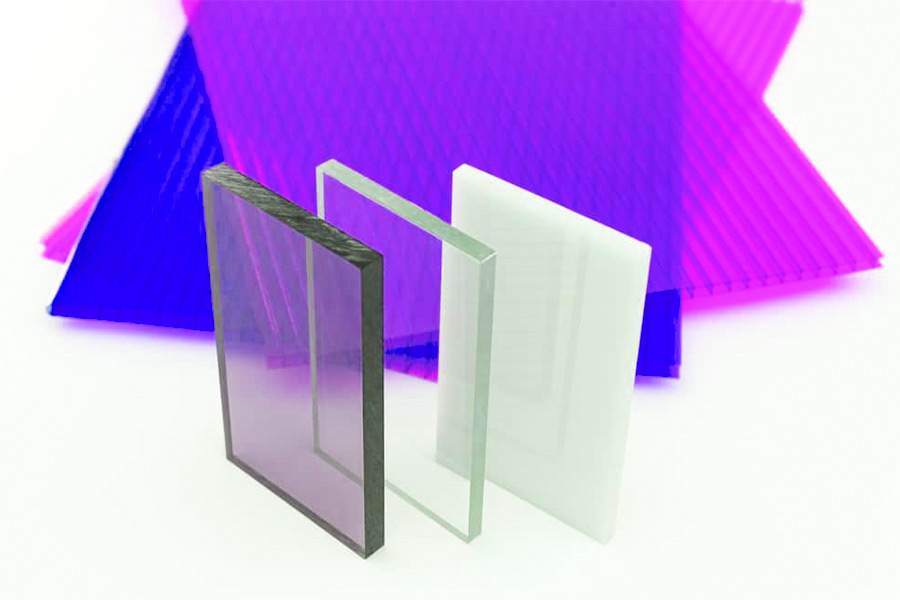
What are the advantages and disadvantages of polycarbonate (PC)?
Polycarbonate is a thermoplastic engineering plastic known for its excellent impact resistance and optical clarity.
Advantages:
- Extremely high impact resistance: Polycarbonate is 250 times stronger than ordinary glass and 30 times stronger than acrylic, so it is often used in protective equipment such as bulletproof glass, safety glasses and helmets.
- High temperature resistance: PC can withstand heat temperatures above 120°C and is suitable for high temperature environments.
- Good optical properties: The light transmittance is close to 90%, and it can be used for optical lenses, LED lampshades, etc.
- Lightweight and easy to process: It can be molded by injection molding, extrusion, etc., and is suitable for complex structural designs.
Disadvantages:
- Easy to scratch: The surface hardness is low, scratches are easy to occur, and coating protection is usually required.
- Not UV-resistant: It will turn yellow when exposed to sunlight for a long time, and UV stabilizers need to be added.
- Higher price: Compared with ordinary plastics, PC costs more.
What is Acrylic?
Acrylic, chemical name polymethyl methacrylate (PMMA), is a transparent thermoplastic, commonly known as "acrylic" or "plexiglass". Its light transmittance is as high as 92%, which is better than ordinary glass. It is also lightweight, weather-resistant and UV-resistant, but has weak impact resistance. Acrylic is made by the polymerization reaction of methyl methacrylate (MMA) and is widely used in advertising signs, lamps, display cabinets, car taillights, sanitary products and decorative materials. It can be formed by hot bending, cutting, polishing and other methods during processing, but it is easy to be scratched, and slightly toxic gases may be released during the production process, so attention should be paid to ventilation protection.
What are the advantages and disadvantages of Acrylic?
The advantages and disadvantages of acrylic (acrylic/PMMA) are as follows:
Advantages:
- High transparency: The light transmittance is up to 92%, which is better than ordinary glass and close to optical glass.
- Lightweight and durable: Half the density of glass, the resistance to shattering is better than glass (but weaker than polycarbonate).
- Strong weather resistance: anti-ultraviolet rays, anti-aging, not easy to yellowing or embrittlement for long-term outdoor use.
- Easy to process: It can be flexibly formed by cutting, hot bending, polishing, bonding, etc., and is suitable for complex designs.
- Lower cost: More affordable than high-performance plastics such as polycarbonate.
- Chemical stability: resistant to weak acids, alkalis and greases, suitable for daily cleaning environment.
Disadvantages:
- Poor impact resistance: susceptible to crushing or scratching by sharp objects, less safe than polycarbonate.
- Poor tolerance to high temperatures: in long periods of use, the temperature usually does not exceed 80-90°C, and it is prone to softening and deformation at high temperatures.
- Flammability: Harmful gases will be emitted during the combustion process, which needs to be improved by adding flame retardants.
- Processing Risks: Cutting or thermoforming may release irritating gases (e.g., MMA monomers) and therefore precautions need to be taken.
- Insufficient surface hardness: susceptible to scratches by hard objects, additional coating protection is required to maintain the appearance.
Is Polycarbonate Truly Unbreakable in Drinking Glasses?
Recently, the popular polycarbonate (PC) water cups on the market often use "not broken" as a selling point, how resistant is this so-called "indestructible" cup? We use measured data and real-world scenarios to uncover the truth for you.
1. Comparison of laboratory limit tests
In a test environment that meets international standards, polycarbonate exhibits impressive impact resistance:
Impact Strength Test (ASTM D256)
- Polycarbonate: 850 joules/m (impact resistance equivalent to bulletproof glass)
- Ordinary acrylic cup: only 24 joules/m
The difference between the two values is 35 times, so that the fall resistance of the polycarbonate cup is close to that of bulletproof materials.
Drop Test (ASTM F1797)
- The polycarbonate cup with a diameter of 9cm fell freely from a height of 1.2 meters to the concrete surface, and several consecutive tests produced only surface scratches
- An acrylic cup of the same size falls from 0.5 meters and has a spiderweb-like crack, and a fall of more than 1 meter is basically completely shattered
2. The technological code of super strong resistance to fall
This special property is due to the unique structure of the material:
Molecular level "rigidity and softness"
- The rigid benzene ring structure forms a strong skeleton
- Flexible carbonate bonds absorb impact energy
- The amorphous structure distributes the pressure by molecular chain sliding
Energy dissolving mechanism
- The impact instantly produces microscopic cracks to buffer energy
- Stress is evenly distributed to avoid local breakage
3. Real-life scenario test
Tested for daily use
- Office desktop (0.7 m height): intact after 10 consecutive falls (80% breakage rate of ordinary glass for the first drop)
- Kitchen worktop (0.9m with water): 5 times down and still able to use normally (ceramic cup 100% broken)
Extreme environment testing
- Quenching and heating from minus 20°C to 100°C: no deformation of the cup
- 500 kg car crushed: only dents and no cracks
4. Precautions for use
Despite the excellent performance, you still need to pay attention to the boundaries of use:
Breaking the tipping point
- Falling from a height of more than 3 meters may cause the mouth of the cup to deform
- Sharp objects, such as hammers, can still penetrate on impact
- Contact with solvents such as acetone may dissolve the surface
Care tips:
- Avoid scratches by hard cleaning tools
- For long-term outdoor use, it is recommended to choose a UV-resistant model
- Deep scratches should be replaced in time
Actual measurements have proved that although the polycarbonate cup is not absolutely "unbreakable", its impact resistance is indeed far beyond that of ordinary materials. For scenarios such as accidental falls and temperature changes in daily use, it can indeed provide reliable protection, which is the best choice for consumers who pursue durability. However, care should be taken to avoid extreme violence and do routine maintenance to prolong the service life.
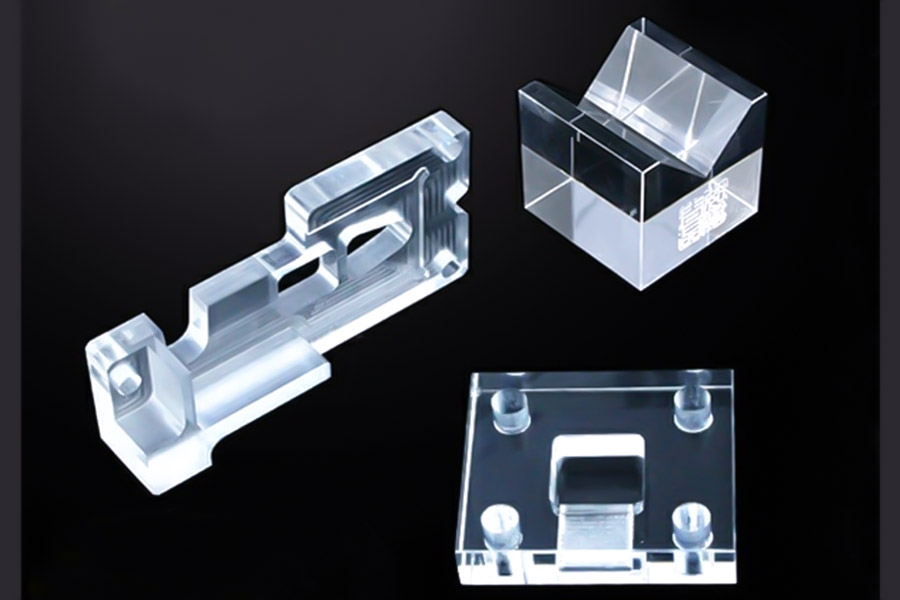
How to Distinguish PC and PMMA with Simple Methods?
PC (polycarbonate) and PMMA (polymethyl methacrylate) are common engineering plastics that can be quickly identified by simple tests such as combustion, buoyancy, appearance, etc., without the need for specialized equipment. Here's a practical guide to low-cost identification:
1. Combustion test method (fast and intuitive)
Steps:
- Take a small sample and fix it on a metal fixture, away from flammable materials;
- Use a lighter to ignite the edge of the sample and observe the flame color and smoke characteristics;
- After the sample is extinguished, residual odors are identified.
Key points of identification:
- PC Material: Yellow flame with a small amount of pale white smoke; When burned, it emits a phenolic odor, similar to burning wood or disinfectants; It is not easy to self-extinguish after leaving the fire, and may continue to burn.
- PMMA Material: Flame is bright blue, smokeless; Releases aromas similar to fruit candy or sweetness; Quickly extinguish after leaving the fire.
- Safety Tips: The test should be conducted in a ventilated environment, and it is recommended to wear protective equipment such as a mask to avoid inhaling smoke.
2. Buoyancy test method (non-destructive testing)
Preparation Materials:
- Saturated saline: dissolve 40g of salt in 100ml of water (density approx. 1.33g/cm³)
- Transparent glass containers
Steps:
- Cut the sample into 1cm³ pieces;
- Let it sit in salt water for 10 seconds to observe the rise and fall.
Result Judgment:
- PC: density 1.20-1.22g/cm³, sink to the bottom after putting in salt water;
- PMMA: density 1.17-1.20g/cm³, suspended in brine or sinking slowly.
3. Comparison of appearance and physical properties
- Light transmittance: PMMA has a light transmittance of over 92%, close to glass; PC transmittance is about 88-90% with a bluish tint on the surface.
- Scratch resistance: Gently scrape the surface with a metal needle, PMMA is easy to leave obvious scratches, and PC is more scratch resistant and has shallow scratches.
- Bending characteristics: PMMA is prone to whitish and fracture when bending; PC is flexible and can rebound after bending significantly.
4. Advanced Identification Methods
- Chemical reagent method: Wipe the surface with acetone, PMMA will quickly become sticky, and there is no obvious change in PC.
- Ultraviolet fluorescence method: Under ultraviolet light irradiation, PMMA exhibits blue-white fluorescence, and PC has no fluorescence reaction.
- Comprehensive suggestion: Combined with the combustion method and the buoyancy method for cross-validation, the accuracy is higher. If you need to accurately judge precision parts, you can further compare indicators such as light transmittance and impact resistance. If you are still unsure, it is recommended to send it to a specialized laboratory for infrared spectroscopy (FTIR) analysis.
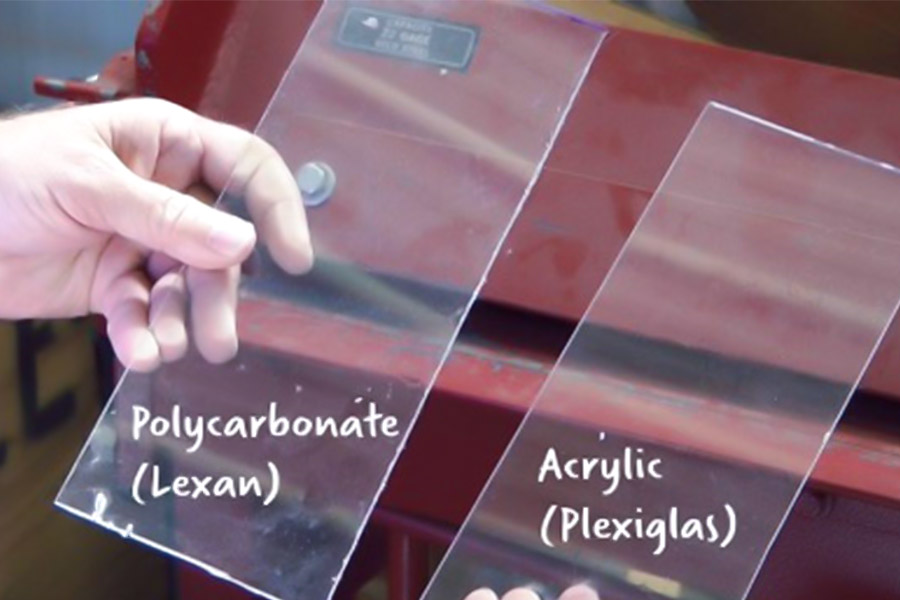
Which Plastic Has Higher Heat Resistance for Dishwasher Use?
The dishwasher is high temperature and humidity, and it is very important to choose the right material for plastic tableware. Based on authoritative test data and industry certifications, the heat resistance of polycarbonate (PC) and acrylic (PMMA) is compared below.
1.High-temperature core data
Test according to ASTM D648 heat deflection temperature:
- Polycarbonate (PC): 1.8MPa load, heat deflection temperature up to 135°C, continuous use temperature from -40°C to 120°C. UL 499 certified to withstand high temperatures of 80°C in the dishwasher.
- Acrylic (PMMA): The heat deflection temperature is only 95°C under the same conditions, and the continuous use temperature is -20°C to 80°C. It is easy to stress whitening at over 60°C, and deformed at more than 80°C.
2.Dishwasher actual performance
Resistance to high temperature steam
- Polycarbonate (PC): 1 hour in 85°C high temperature steam, no deformation, no fogging, surface hardness to maintain HV 110. After 100 dishwasher cleanings, the light transmittance was slightly reduced from 90% to 88%.
- Acrylic (PMMA): 30 minutes in 70°C steam with micro-cracks, warped edges, and a surface hardness reduced from HV 105 to HV 85. After 50 dishwasher sessions, light transmittance dropped dramatically from 92% to 78%.
In summary, polycarbonate is much more resistant to high temperatures than acrylic and is more suitable for dishwashers. When buying plastic tableware, pay attention to the material characteristics and certifications can ensure the safety of use and the life of the product.
3. Additional comparison of chemical resistance
(1) Dishwashing agent corrosion test
| Test items | Polycarbonate (PC) | Acrylic acid (PMMA) |
|---|---|---|
| Alkaline dishwashing agent immersion | No corrosion (pH 10) | Surface atomization (pH 9+) |
| Grease residue cleaning ability | Strong resistance to oil stains | Easy to leave oil stains and scratches |
A quick guide to material selection
[Three Scenarios of Optimal PC]
- High temperature sterilization: resistant to long-term steam in the dishwasher at 80°C
- High-frequency use: gym/outdoor products are fall-resistant and wear-resistant
- Food and medical: FDA/UL certified safe products
[Three scenarios for disabling PMMA]
- High temperature cleaning: Commercial dishwasher 70°C program disabled
- Large containers: products with a diameter of > 20cm are easy to crack when hot and cold
- Children's tableware: risk of deformation due to high-temperature liquid perfusion
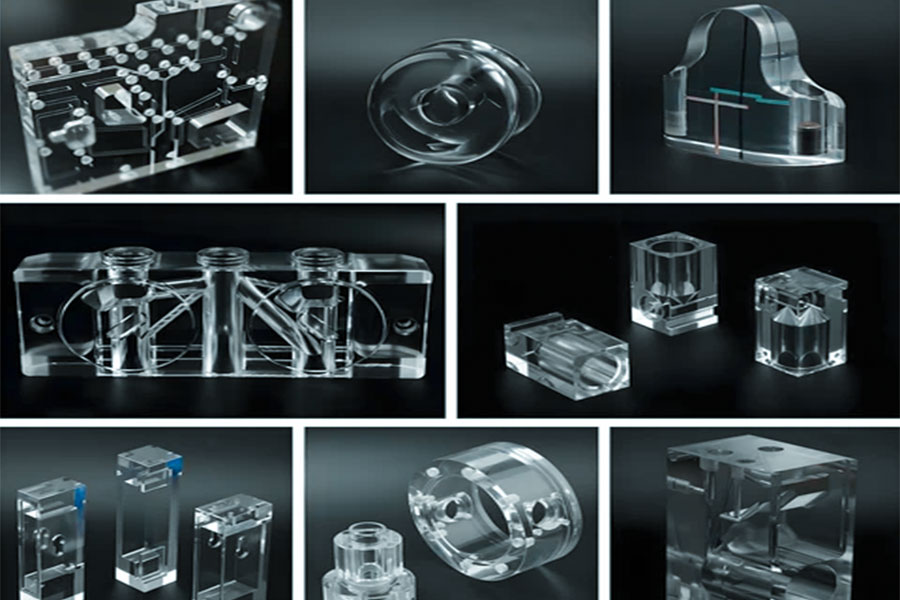
Are Polycarbonate Cups BPA-Free and Food-Safe?
Polycarbonate (PC) water bottles are favored for their lightweight and drop-resistant properties, but consumers are always concerned about whether they contain bisphenol A (BPA) and whether they meet food safety standards. This article will combine international certification data with laboratory tests to dissect the truth for you.
1. BPA risk and safety standards for traditional PC cups
In the traditional PC production process, bisphenol A (BPA) is an essential raw material for the synthesis of carbonate bonds, so it is inevitable that some amount of BPA will remain in the finished product. To ensure safety, many countries have set strict standards:
- U.S. FDA 21 CFR 177.1580: Requires BPA migration of less than 0.6 ppm per kilogram of food in food contact materials and allows conventional PCs to be used in food containers (although their use in baby bottles has been banned since 2012).
- China GB 4806.6-2016: The migration limit of BPA is also set at ≤0.6mg/kg, which is consistent with the US standard.
2. Breakthrough in new BPA-Free PC technology
To eliminate BPA risks, the industry has developed several new technologies:
- TPP (triphenyl phosphate) substitution technology: using a modified synthesis process of BPA-free plasticizers, the BPA content in the finished product has been tested by SGS to be less than 0.01ppm.
- Other eco-friendly processes, including polyester PC (e.g. Tritan™) and bio-based PC (plant derivatives instead of petroleum feedstocks), eliminate the use of BPA at the source.
3. Comparison of food safety certification levels
(1) International mainstream certification systems
| Certification standards | Traditional PC | BPA-Free PC |
|---|---|---|
| US FDA | ✔️ | ✔️ (additional statement required) |
| EU EU 10/2011 | ❌ | ✔️ (migration amount < 0.05ppm) |
| Japan JHOSPA | ❌ | ✔️ (food grade label) |
| China GB 4806.6 | ✔️ | ✔️ (upgraded version of the test) |
4. Consumer Purchase and Use Guide
(1) Methods for identifying safety products
- Check product identification: Prefer products labeled "BPA-free" or "Tritan" and confirm that the packaging has a food contact material certification number (e.g., LFGB in Germany, NSF in the United States, etc.).
- Choose low-priced products carefully: Avoid buying unbranded, non-test reports for PC cups, which may use recycled materials, which increases the risk of excessive BPA.
(2) Precautions for daily use
- Temperature control: It is recommended to use hot water no more than 80°C, high temperatures may accelerate BPA release; Do not put in the microwave oven PC cups that are not marked "microwaveable".
- Cleaning & Replacement: Avoid scrubbing with steel wool to prevent scratches and increase the risk of BPA residue; It is recommended to replace the PC cup every 2 years to ensure that it is safe to use.
Through technological innovation and strict standard control, BPA-free polycarbonate products have been able to meet food safety needs, but consumers still need to purchase and standardize their use through formal channels to ensure their health and worry-free.
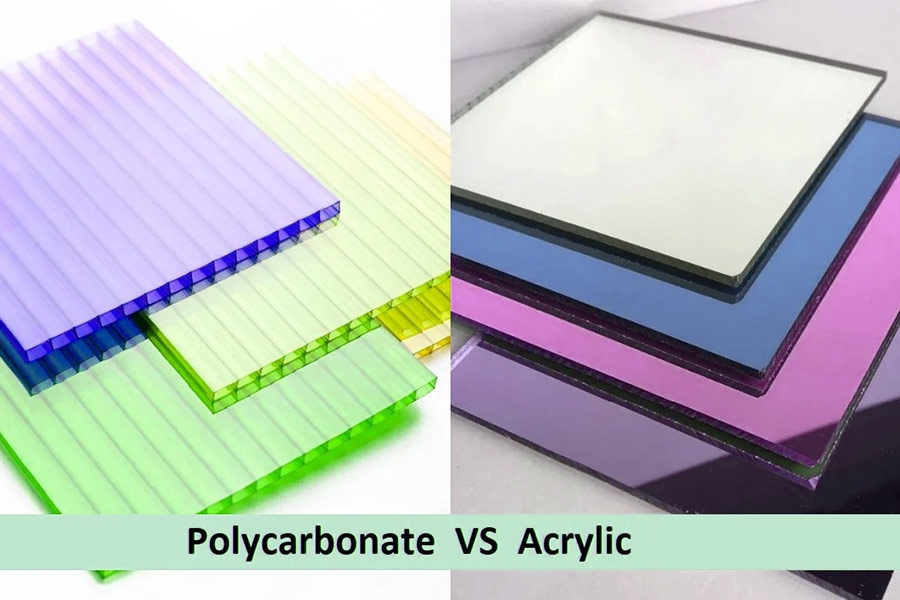
Why Do Luxury Brands Prefer Acrylic for Champagne Flutes?
In the high-end wine glasses market, acrylic (PMMA) is gradually replacing traditional glass and polycarbonate (PC) to become the preferred material for luxury brand champagne glasses.
1. Optical performance crushing advantage
(1) Extreme light transmission performance (ASTM D1003 standard)
① Transmittance comparison
- PMMA: Transmittance 92% (same as crystal glass)
- PC: Initial transmittance is only 88%, which drops to 82% after 2 years of use (due to yellowing effect)
- Glass: Transmittance is about 91%, but a green edge effect occurs when the thickness is greater than 3mm
② Color reproduction
- PMMA Abbe number (dispersion coefficient) reaches 58, close to optical glass (60+), ensuring the true presentation of champagne gold color and bubble trajectory
- PC Abbe number is only 34, and there is a slight visual blur
2. Luxury-level standards for surface treatment
(1) Hardness and wear resistance (ISO 15184 pencil hardness)
| Material | Surface hardness | Scratch resistance | Gloss after polishing (GU) |
|---|---|---|---|
| PMMA | 3H | Can withstand friction from metal knives and forks | 95-100 (crystal-like effect) |
| PC | HB | Can leave scratches with nails | 80-85 (needs coating for brightening) |
| Glass | 6H | Very high but fragile | 98-102 (natural gloss) |
(2) Fine processing capability
① Turning and engraving:
- PMMA can be embossed with a precision of 0.1mm (such as LV old flower texture)
- PC has a low thermal deformation temperature, so engraved details are easy to melt and collapse
② Edge polishing:
- PMMA can achieve a mirror-like cup mouth after being cut by a diamond knife
- PC still has a slight matte feeling after polishing
3. The luxury gene of user experience
(1) Lightweight and safety
- Weight control: The PMMA cup (200ml) weighs only 85g, which is 60% lighter than the glass cup (210g), making it easier to hold
- Drop resistance: In a 1-meter drop test, the breakage rate of the PMMA cup is less than 5%, while the breakage rate of the glass cup is greater than 90%
(2) Temperature performance
- Chill maintenance: PMMA has a thermal conductivity of 0.19 W/m·K, which thaws more slowly than glass (1.05 W/m·K), maintaining the best taste of champagne
- Condensation control: The condensation rate on the cup wall is 3 times slower than that on glass, preventing wet hands
Which Material Costs Less for Mass Production?
From the analysis of mass production economy, the comprehensive production cost of PMMA (acrylic) is significantly lower than that of PC (polycarbonate). The core differences are as follows:
Raw material cost advantage
The price of PMMA granules (23 yuan/kg) is only 55% of that of PC (42 yuan/kg), and the price difference per kilogram is 19 yuan. According to the annual output of 10,000 tons, the annual cost gap of raw materials alone can reach 190 million yuan.
Machining loss control
- The PMMA injection molding rejection rate is <2%, and the process window is wide
- PC requires an additional drying system (moisture content < 0.02%), and the drying energy consumption is increased by 15-20%
- Risk of PC hydrolysis leads to a 3-5% increase in potential scrap (when not up to standard drying)
Differences in equipment investment
The PC production line needs to be equipped with precision drying equipment (about 30% more equipment input) and a humidity monitoring system, while PMMA can use a standard injection molding line.
Comparison of production efficiency
- The injection cycle of PMMA is 8-12% shorter than that of PC, and the production capacity of the same equipment is increased by about 10%, further diluting the unit cost.
- In large-scale production, PMMA has a significant cost advantage over PC (30-40% lower overall cost), especially in the field of optical/decorative parts where temperature resistance is required < 80°C. However, in high-impact, high-temperature (>120°C) scenarios, a PC is still required.
Summary
Polycarbonate (PC) and acrylic (PMMA) each have their own unique advantages, and the choice depends on specific needs. PC is known for its ultra-high impact resistance (30 times that of acrylic) and high temperature resistance (135°C), and is suitable for scenes such as safety protection and automotive parts, but it is easy to scratch and has a high cost; acrylic wins with 92% light transmittance and weather resistance, and is suitable for advertising signs, building lighting and other fields that require high transparency and outdoor use, but it has weak impact resistance and is not resistant to high temperatures. If you need to take into account both transparency and durability, you can consider PC+PMMA composite sheets. After understanding the characteristics of the two, reasonable material selection can maximize performance and cost-effectiveness!
📞 Phone: +86 185 6675 9667
📧 Email: info@longshengmfg.com
🌐 Website: https://lsrpf.com/
Disclaimer
The content of this page is for informational purposes only.LS SeriesNo representations or warranties of any kind, express or implied, are made as to the accuracy,completeness or validity of the information. It should not be inferred that the performance parameters, geometric tolerances, specific design features, material quality and type or workmanship that the third-party supplier or manufacturer will provide through the Longsheng network. This is the responsibility of the buyerAsk for a quote for partsto determine the specific requirements for these parts.please Contact us Learn more information.
LS Team
LS is an industry-leading companyFocus on custom manufacturing solutions. With over 20 years of experience serving more than 5,000 customers, we focus on high precisionCNC machining,Sheet metal fabrication,3D printing,Injection molding,metal stamping,and other one-stop manufacturing services.
Our factory is equipped with more than 100 state-of-the-art 5-axis machining centers and is ISO 9001:2015 certified. We provide fast,efficient and high-quality manufacturing solutions to customers in more than 150 countries around the world. Whether it's low-volume production or mass customization,we can meet your needs with the fastest delivery within 24 hours. chooseLS TechnologyIt means choosing efficiency, quality and professionalism.
To learn more, please visit our website:www.lsrpf.com

FAQs
1. Is polycarbonate plastic better than acrylic plastic?
Polycarbonate (PC) and acrylic (PMMA) have their own advantages and disadvantages, depending on the application. PC has extremely strong impact resistance (35 times that of PMMA) and high temperature resistance (135°C), which is suitable for safety protection and high-temperature environments; PMMA, on the other hand, has higher light transmittance (92%), scratch resistance, and UV resistance, making it more suitable for optical products and outdoor signage. There is no absolute "better", you need to choose according to your needs.
2. How can you tell if something is polycarbonate or acrylic?
It can be quickly distinguished by the combustion method (PC burns black smoke and has a pungent phenolic smell, and there is no black smoke with fruity aroma when PMMA is burned), buoyancy test (PC sinks in saturated salt water, PMMA floats) or hardness test (PC nails can be scratched, PMMA surface is harder), and it is recommended to use the buoyancy method preferably for home operation, which is safe and does not require professional equipment.
3. Which is better, polycarbonate cup or acrylic cup?
Polycarbonate cups are more suitable for daily high-frequency use because they are resistant to drops (1.2 meters drop without cracking) and high temperature resistance (dishwasher safe), but easy to scratch, acrylic cups have better light transmission and a crystal like glass appearance, suitable for display or short-term use, but have poor impact resistance (easy to crack after 0.5 meters fall). Choose according to the use scenario: PC for durability and PMMA for aesthetics.
4. Is acrylic or polycarbonate more brittle?
Acrylic (PMMA) is obviously more brittle, and its essence is a hard and brittle material. The impact strength of polycarbonate (PC) is as high as 850 J/m (ASTM D256 standard), which is more than 35 times that of PMMA (24 J/m). The difference in brittleness comes from the molecular structure: the linear polymer chain of PMMA lacks flexible bonds, and the energy cannot be dispersed when impacted, which directly leads to crack propagation and star-shaped fragmentation; while the carbonate bonds of PC allow the molecular chain to slide, and the overall rupture is avoided through microcrack buffering and energy absorption. The actual performance is: PMMA cups may break into sharp fragments if they fall from 0.5 meters, while PC cups will only be dented or slightly scratched even if they fall from 1.2 meters, which is safer. In addition, PMMA brittleness is further aggravated in low temperature environments (such as -20℃), while PC can still maintain toughness.






